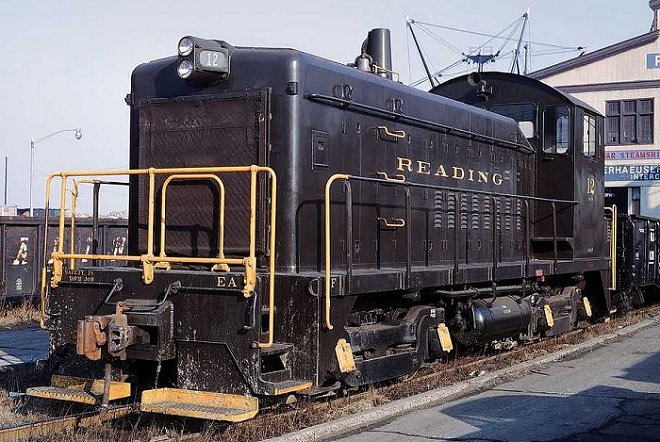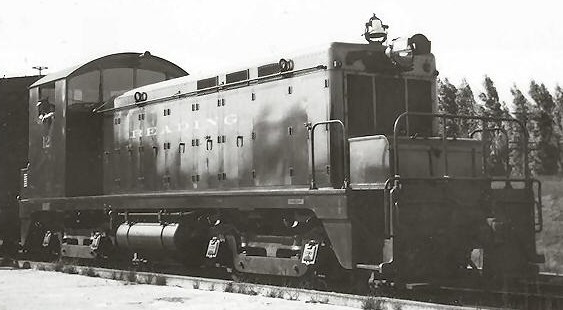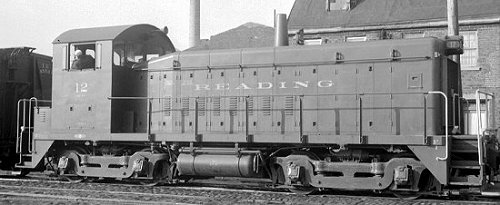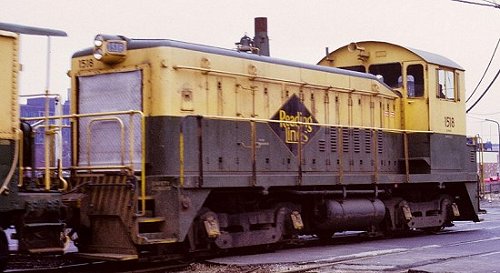EMD: SW
 The EMD "SW" (Six hundred HP, Welded frame) class of locomotives was one of the earliest end-cab switchers in existence. This design offered better visibility in both directions for the crew, and was an improvement over the earlier boxcab configuration that was the hallmark of the earliest diesels. In late 1937, the Reading received 6 EMD SW locomotives, classed OE-3 (Oil-Electric, 3rd type), and numbered #10-15. These units were powered by the Winton 201 engine, which was a precursor to the later (and widely used) EMD 567 prime mover. The photo below shows locomotive #12 in its as-delivered configuration. One can see the genesis of the popular EMD end-cab design; however, note some interesting spotting features: The unusual headlight, the three vents along the hood, the positioning of the bell, and the large sandbox on the front of the locomotive. Several of these features were carried forward into the follow-on SW1 class of locomotives. Upon delivery, the Reading's OE-3 switchers were assigned to service along the Philadelphia waterfront.
The EMD "SW" (Six hundred HP, Welded frame) class of locomotives was one of the earliest end-cab switchers in existence. This design offered better visibility in both directions for the crew, and was an improvement over the earlier boxcab configuration that was the hallmark of the earliest diesels. In late 1937, the Reading received 6 EMD SW locomotives, classed OE-3 (Oil-Electric, 3rd type), and numbered #10-15. These units were powered by the Winton 201 engine, which was a precursor to the later (and widely used) EMD 567 prime mover. The photo below shows locomotive #12 in its as-delivered configuration. One can see the genesis of the popular EMD end-cab design; however, note some interesting spotting features: The unusual headlight, the three vents along the hood, the positioning of the bell, and the large sandbox on the front of the locomotive. Several of these features were carried forward into the follow-on SW1 class of locomotives. Upon delivery, the Reading's OE-3 switchers were assigned to service along the Philadelphia waterfront.

 In 1956, after nearly 20 years of service, the entire group of OE-3 switchers were sent to EMD for a comprehensive rebuild. While retaining their original road numbers and some components, these units were repowered with 567 prime movers, upgraded to 660 horsepower, and designated as SW900s, Reading class OE-13. At the same time, the hood was rebuilt to its familiar full length, losing the rounded sandbox, and the cab windows were squared off. In addition, the headlights were replaced with twin sealed-beam headlights, and handrails were added to the walkways. The photos below and at the top of the page show Reading OE-13 #12 in its rebuilt configuration. One will see that it clearly has the familiar appearance of the "standard" EMD end-cab switcher. Note that the locomotive retained the carbody handrail in addition to the new handrail along the walkway!
In 1956, after nearly 20 years of service, the entire group of OE-3 switchers were sent to EMD for a comprehensive rebuild. While retaining their original road numbers and some components, these units were repowered with 567 prime movers, upgraded to 660 horsepower, and designated as SW900s, Reading class OE-13. At the same time, the hood was rebuilt to its familiar full length, losing the rounded sandbox, and the cab windows were squared off. In addition, the headlights were replaced with twin sealed-beam headlights, and handrails were added to the walkways. The photos below and at the top of the page show Reading OE-13 #12 in its rebuilt configuration. One will see that it clearly has the familiar appearance of the "standard" EMD end-cab switcher. Note that the locomotive retained the carbody handrail in addition to the new handrail along the walkway!

In 1970-1971, the OE-13 locomotives were rebuilt AGAIN, this time into SW900m switchers numbered #1516-1521, and reclassed SWE-4. When rebuilt, the locomotives were repainted into the second-generation yellow and green paint scheme. In 1972, #1519 was repainted into the "Reading Green" scheme. The principal spotting difference between these units and the Reading's other SW900s was the presence of a carbody AND walkway handrail as seen at right. The other SW900s only had the walkway handrails installed. After this second rebuild, these units worked primarily around Reading, Coatesville, and Philadelphia. Due to being rebuilt twice, these locomotives had an unusually long service life, remaining on the Reading up until April, 1976, and continuing on well into Conrail.
MODELING NOTES:
As can be seen from the photos above, modeling these locomotives at any time after their 1956 rebuild should be a fairly straightforward task, given their outward appearance as a standard EMD end-cab switcher. Modeling them in their original state will take some effort to fabricate the unique hood, and including appropriate details such as the headlight, bell, etc. From 1956 onward, remember to include both the carbody and walkway handrail, as this was a principal spotting difference between the SW900ms and the Reading's other SW900s. If you're going to include one of these locomotives on your layout, be sure to consider the proper road number and class for your era - these units were renumbered in the 1500 series after their 1970-71 rebuild; prior to that they still carried their original numbers 10-15, as well as their Pullman Green paint. From an operations standpoint, they were primarily seen around Philadelphia in their early days, but saw service in Reading, Coatesville and that general area in the 1970s.
Did You Know?
Downloads
 A variety of Reading Company operations related documents, etc. that may be of use in your modeling efforts.
A variety of Reading Company operations related documents, etc. that may be of use in your modeling efforts.
 A variety of Reading Company operations paperwork, such as train orders, clearance forms, etc. that will help you operate your Reading layout in a prototypical manner.
A variety of Reading Company operations paperwork, such as train orders, clearance forms, etc. that will help you operate your Reading layout in a prototypical manner.
 Public Timetables, Employe Timetables, and Rulebooks that provide much useful operational information.
Public Timetables, Employe Timetables, and Rulebooks that provide much useful operational information.
 Signs, billboards, and other FREE goodies for your use. We ask only that you help spread the word about The Reading Modeler!
Signs, billboards, and other FREE goodies for your use. We ask only that you help spread the word about The Reading Modeler!

